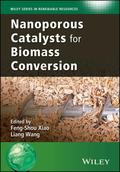Nanoporous Catalysts for Biomass Conversion
Wiley Series in Renewable Resources

1. Edition October 2017
336 Pages, Hardcover
Wiley & Sons Ltd
A comprehensive introduction to the design, synthesis, characterization, and catalytic properties of nanoporous catalysts for the biomass conversion
With the specter of peak oil demand looming on the horizon, and mounting concerns over the environmental impact of greenhouse gas emissions, biomass has taken on a prominent role as a sustainable alternative fuel source. One critical aspect of the biomass challenge is the development of novel catalytic materials for effective and controllable biomass conversion. Edited by two scientists recognized internationally for their pioneering work in the field, this book focuses on nanoporous catalysts, the most promising class of catalytic materials for the conversion of biomass into fuel and other products.
Although various catalysts have been used in the conversion of biomass-derived feedstocks, nanoporous catalysts exhibit high catalytic activities and/or unique product selectivities due to their large surface area, open nanopores, and highly dispersed active sites. This book covers an array of nanoporous catalysts currently in use for biomass conversion, including resins, metal oxides, carbons, mesoporous silicates, polydivinylbenzene, and zeolites. The authors summarize the design, synthesis, characterization and catalytic properties of these nanoporous catalysts for biomass conversions, discussing the features of these catalysts and considering future opportunities for developing more efficient catalysts. Topics covered include:
* Resins for biomass conversion
* Supported metal oxides/sulfides for biomass oxidation and hydrogenation
* Nanoporous metal oxides
* Ordered mesoporous silica-based catalysts
* Sulfonated carbon catalysts
* Porous polydivinylbenzene
* Aluminosilicate zeolites for bio-oil upgrading
* Rice straw Hydrogenation for sugar conversion
* Lignin depolymerization
Timely, authoritative, and comprehensive, Nanoporous Catalysts for Biomass Conversion is a valuable working resource for academic researchers, industrial scientists and graduate students working in the fields of biomass conversion, catalysis, materials science, green and sustainable chemistry, and chemical/process engineering.
Authors: Xiang Zhu, Chi-Linh Do-Thanh and Sheng Dai
1.Introduction
2.Nanoporous Crystalline Organic Frameworks Metal-promoted organic transformations in glycerol
3.Nano porous Organic Sulfonated Resins
4.Conclusions and Perspective
References
Chapter 2: Activated Carbon and Ordered Mesoporous Carbon-based Catalysts for Biomass Conversion
Authors: Xiaochen Zhao, Jifeng Pang, Guangyi Li, Fei Liu, Jinming Xu, Mingyuan Zheng, Ning Li, Changzhi Li, Aiqin Wang, and Tao Zhang
1.Introduction
2.Activated Carbon and Mesoporous carbon
3.Cellulose conversion
4.Lignin conversion
5.Synthesis of Biofuel (diesel or jet fuel) from lignocellulose
6.Summary
References
Chapter 3: Nanoporous Carbon/Nitrogen-Materials and Their Hybrids for Biomass Conversion
Authors: Hui Su, Hong-Hui Wang, Tian-Jian Zhao, Xin-Hao Li
1.Introduction
2.Dehydrogenation of Formic Acid
3.Transfer Hydrogenation of Unsaturated Compounds from Formic Acid
4.Synthesis of Highly Value-added Chemicals from Biomass
5.Metal-free Catalyst - Graphene Oxide for the Conversion of Fructose
6.Conclusions and Outlook
References
Chapter 4: Recent developments in the use of porous carbon materials for cellulose conversion
Authors: Abhijit Shrotri, Hirokazu Kobayashi and Atsushi Fukuoka
1.Introduction
2.Overview of catalytic cellulose hydrolysis
3.Functionalized carbon catalyst for cellulose hydrolysis
4.Summary and outlook
References
Chapter 5: Ordered Mesoporous Silica-Based Catalysts for Biomass Conversion
Authors: Liang Wang, Shaodan Xu, Xiangju Meng, Feng-Shou Xiao
1.Introduction
2.Sulfated Ordered Mesoporous Silicas
3.Ordered Mesoporous Silica Supported Polyoxometalates and Sulfated Metal Oxides
4.Hetero-atom doped ordered mesoporous silica
5.Ordered Mesoporous Silica Supported Metal Nanoparticles
6.Overall Summary and Outlook
References
Chapter 6: Porous polydivinylbenzene based solid catalysts for biomass transformation reactions
Authors: Fujian Liu and Yao Lin
1.Introduction
2.Synthesis of porous PDVB-based solid acids and investigate their catalytic performances
3.Perspectives in the PDVB based solid catalysts and their application for biomass transformations
Acknowledgement
References
Chapter 7: Designing zeolite catalysts to convert glycerol, rice straw and for bio-gasoline direct synthesis from bio-syngas
Authors: Chuang Xing, Guohui Yang, Ruiqin Yang and Noritatsu Tsubaki
1.Glycerol Convert to Propanediols
2.Rice Straw Hydrogenation
3.Bio- Gasoline Direct Synthesis
References
Chapter 8: Catalytic Depolymerization of Lignin to Fuels and Chemicals: A Review
Authors: Zhicheng Luo, Jiechen Kong, Liubi Wu, Chen Zhao
1.Introduction
2.Developed techniques for lignin depolymerization
3.Oxidative depolymerization of lignin
4.Hydrolysis of lignin with base and acid catalysts
5.Other depolymerization techniques (cracking, photocatalysis, electrocatalysis, and biocatalysis)
6.Conclusions
Acknowledgement
References
Chapter 9: Mesoporous Zeolite for Biomass Conversion
Authors: Liang Wang, Shaodan Xu, Xiangju Meng, Feng-Shou Xiao
1.Introduction
2.Production of biofuels
3.Conversion of Glycerol
4.Overall summary and outlook
Chapter 10: Lignin depolymerization over porous copper based mixed oxide catalysts in supercritical ethanol
Authors: Emiel J.M. Hensen
1.Introduction
2.Lignin depolymerization by CuMgAl mixed oxide catalysts in supercritical ethanol
3.Conclusion
References
Chapter 11: Niobium-based catalysts for biomass conversion
Authors: Qineng Xia, Yanqin Wang
1.Introduction
2.Hydrolysis
3.Dehydration
4.HMF Hydration to LA
5.Hydrodeoxygenation
6.C-C coupling reactions
7.Esterification/transesterification
8.Other reactions in biomass conversion
9.Summary and Outlook
References
Chapter 12: Towards more sustainable chemical synthesis via using formic acid as a renewable feedstock
Authors: Shu-Shuang Li, Lei Tao, Yong-Mei Liu and Yong Cao
1.Introduction
2.General properties of FA and the implications for green synthesis
3.Transformation of bio-based platform chemicals
4.FA-mediated Depolymerization of lignin or chitin
5.Upgrading of bio-oil and related model compounds
6.FA as the direct feedstock for bulk chemical synthesis
7.Conclusion and Outlook
References
Feng-Shou Xiao, Zhejiang University, Hangzhou, China
Liang Wang, Zhejiang University, Hangzhou, China
Series Editor
Christian Stevens, Faculty of Bioscience Engineering, Ghent University, Belgium


